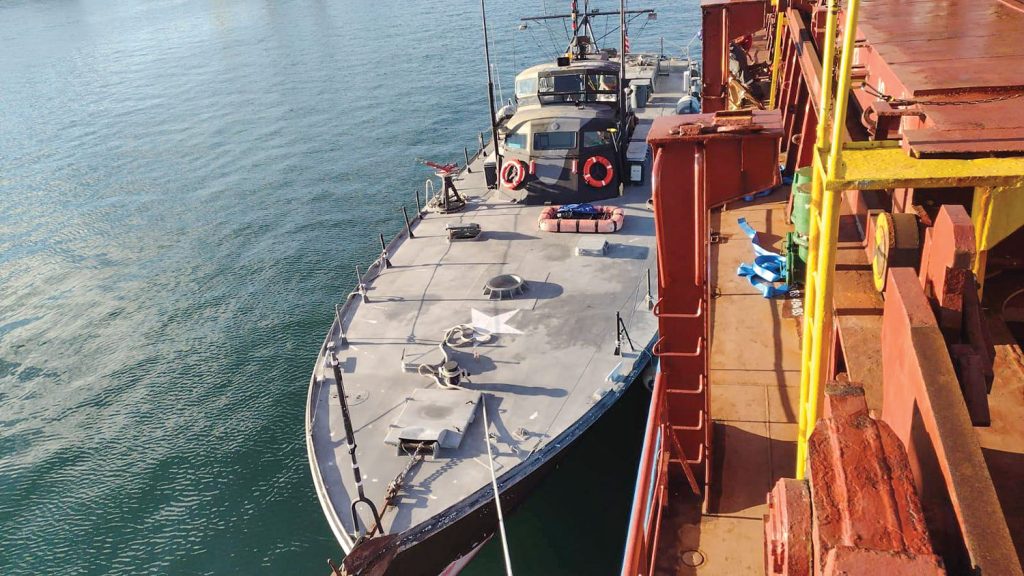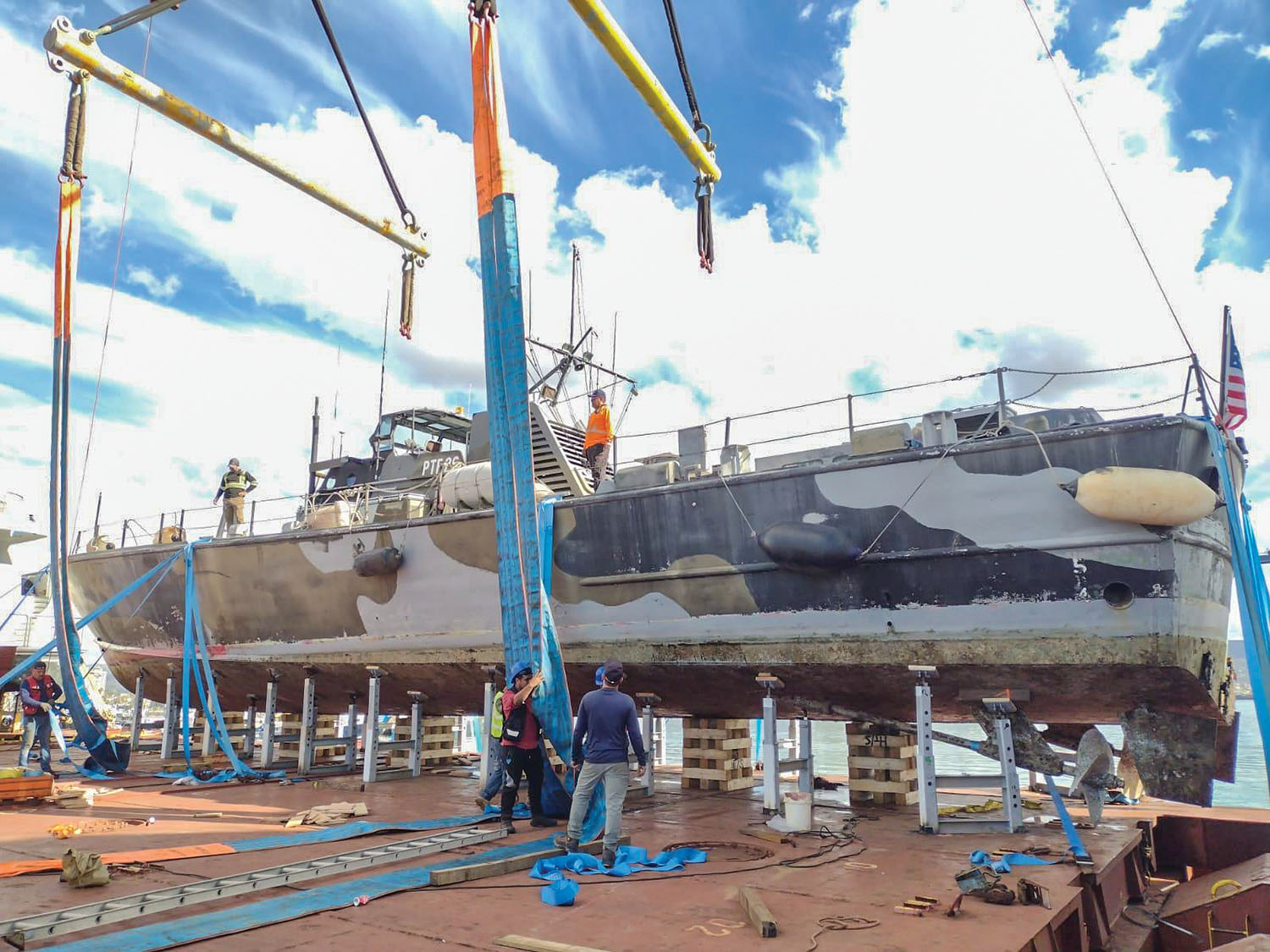A Vietnam-era PT boat owned by a Paducah, Ky.-based foundation is on its way to the inland waterways with a mission of training and inspiring youth who live near the rivers.
The Maritime Pastoral Training Foundation (MPTF) bought PTF-26, known as the “Last American PT Boat” in 2020. Unexplained mechanical problems, COVID-19 restrictions and other issues prevented PTF-26 from being moved from its temporary mooring in Morro Bay, Calif., until recently.
Now the boat is finally on its way, being carried as deck cargo on board the mv. BBC Michigan. Having transited the Panama Canal on January 3, it is expected to arrive in Port Everglades, Fla., within days. From there, Capt. Gary Fischmann, an MPTF founder and board member and the vessel’s permanent skipper, will take PTF-26 to Mobile, Ala. Ingram Barge Company’s Capt. Mike “Turbo” Hughes and Capt. Kyle Rosenwald will then relieve Fischmann, navigating PTF-26 on the 700-mile trek up the Tenn-Tom and Ohio to its new home at the state-owned marina in Golconda, Ill., said the Rev. Kempton Baldridge, MPTF’s managing director and a retired Navy chaplain.

PTF-26 was constructed in 1968 as the very last of the 841 PTF boats built by the U.S. Navy from 1940 to 1968. Only nine PT boats remain, and just two of those are operational: PT-658 in Portland, Ore., and PTF-26.
PTFs had a design speed of 40-plus knots. They were derived from the PT boats used in World War II. The first two PTFs built were post-WWII PT boats, and the next 20 were 80-foot wood boats, known as the “Nasty” class. The last four PTFs were 95-foot aluminum boats known as “Osprey” class. Today, of the four Osprey class boats, only two survive, PTF-23, which has been heavily modified as a research vessel, and PTF-26.
World War II PT boats used torpedoes to attack enemy shipping, but PTFs were heavily armed, near-coastal gunboats primarily used to support special forces. PTF-26 completed two tours of duty in Vietnam from 1969-70 and 1970-71. With the 1971 drawdown of U.S. forces in Vietnam, PTF-26 returned to the U.S., where the Navy used the boat on the West Coast for patrol, training and equipment testing. In 1998, PTF-26 was transferred to Sacramento-based non-profit Liberty Maritime Inc. and renamed T/V Liberty. For two decades, the vessel served as the nation’s first Sea Scout training ship with an all-female crew. MPTF purchased the boat in March 2020, restoring its name to the original hull number PTF-26.
Capt. Don Welborn, assisted by friend and first mate for the trip Dave Bernard, piloted PTF-26 from Morro Bay to San Diego, Calif., December 14-16 for the first part of the historic vessel’s long voyage to serving youth on America’s rivers, before Fischmann took it from San Diego to Ensenada, Mexico, to meet the mv. BBC Michigan.
Welborn is a long-tenured commercial fisherman, who mainly fishes for salmon, tuna and rock cod out of Morro Bay. Some of Welborn’s tuna boats are of similar size to PTF-26, and he was already familiar with the engines and gen sets from working on his own vessels, he said, so when he heard from the local gear shop that a pilot was needed for the trip from Morro Bay to San Diego, he offered his services.
Welborn’s father, Duane “Bud” Welborn, was in the Navy, serving on the supercarrier U.S.S. Ranger (CV-61) in the Vietnam era, and Welborn grew up on and near military bases both in Florida and on the West Coast. He said PTF-26 reminds him of the boats he used to see around the bases.
“I really enjoyed taking that boat down there with that history,” he said.
He said he checked out the bilges, plates and gearing and found PTF-26 to be remarkably sound for its age and set up to be simple to operate and with a functional layout. “Not so complicated,” he said. “Not like the new stuff.”
“That boat handles and tracks pretty well,” he added.
He was particularly impressed by the twin Detroit Diesel 16v71 main engines, which replaced its original Napier Deltics during a 2013 repowering.
“Those are great engines, and if they take care of them, that will last them a long time,” he said.
Fischmann said PTF-26 does need some repairs because of noticeable vibration at higher engine speeds, so it will spend some time on drydock before taking on its new mission.
That’s especially important because, “She’s going to be a working museum ship,” he said. “She’s not just going to be a static museum piece.”
Baldridge noted that there are 164 Sea Scout, Sea Cadet and NJROTC units within five hours of Golconda.
“Each weekend, 12-15 cadets or scouts will do more than take a tour of a U.S. Navy PT boat,” he said. “They will eat, sleep and train aboard as crew trainees. With a USCG licensed captain in command, PTF-26 will get underway with cadets or scouts as crew, guided by adult officers of their own unit. In port, cadets will learn everything there is to know about PTF-26. When ‘visit ship’ is held on Saturdays and Sundays for members of the public, qualified uniformed cadets and scouts of the crew will conduct tours, just as on board Navy and Coast Guard vessels.”
Baldridge added that tours will always be free of charge, also like Navy and Coast Guard vessels, since PTF-26 is registered as a “vessel in public service.”
Both Baldridge and Rosenwald started out their maritime careers as Sea Cadets. Fischmann and Rosenwald are also Coast Guard veterans.
PTF-26’s mission is rare. All three Sea Cadet training ships on the Great Lakes were sold off or relocated in 2022, Baldridge said. That leaves PTF-26 and a former Coast Guard cutter in Texas as the only youth training ships located between the U.S. East and West coasts, and the PTF-26 as the only one on the inland waterways.
For Hughes, the boat’s Golconda, destination is a connection. He is a lifelong resident of Golconda and grew up hearing stories about PTFs told by the late Capt. Jim Ed Roper, two-term mayor of Golconda and former commanding officer of a flotilla of PTFs.
Fischmann said he can’t wait to be part of PTF 26’s important mission, but he’s also excited for the fun, when cadets and scouts feel what he did when he was piloting PTF-26 between San Diego and Ensenada.
“When those mains start up and you can feel them through your feet, oh, yeah, it’s like she wants to go,” he said. “And she handles like a dream, too.”
Caption for top photo: PTF-26 loaded in its travel cradle on the mv. BBC Michigan prior to traveling through the Panama Canal and then across the Gulf of Mexico and around Florida to Port Everglades. (Photo courtesy of Maritime Pastoral Training Foundation)




